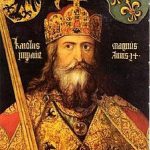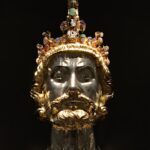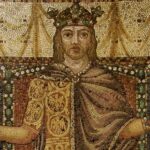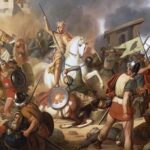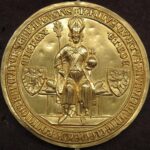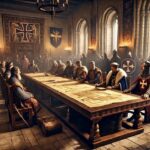
Imagine an empire born from the ghost of Rome, ruled by kings crowned by popes, stitched together from dozens of duchies, cities, and bishoprics. It wasn’t quite holy, or Roman, or an empire—at least not in the way you’d expect. Yet for over 1,000 years, the Holy Roman Empire played a central role in shaping the political, religious, and cultural destiny of Europe.
From Charlemagne’s coronation in 800 CE to its dissolution under Napoleon in 1806, this empire was a bold and often messy experiment in uniting Christendom under one banner. It gave birth to ideas of kingship, law, and identity that still echo in modern Germany and across Europe today.
Let’s dive into the rich, complex legacy of the Holy Roman Empire—and why it mattered so much.
Origins: From Charlemagne to Otto I
The Holy Roman Empire was born on Christmas Day, 800 CE, when Pope Leo III crowned Charlemagne as Emperor of the Romans in St. Peter’s Basilica. It was a political masterstroke: the Church elevated a loyal Frankish king while reviving the dream of a unified Christian empire in the West.
But Charlemagne’s empire didn’t last. After his death in 814, the Carolingian Empire fractured. It wasn’t until Otto I of Germany—king of the Eastern Frankish kingdom—defeated the Magyars and secured Italy that the idea of the empire was revived.
In 962, Otto was crowned by the pope as the new Roman Emperor, marking the beginning of what historians now call the Holy Roman Empire.
What Was the Empire, Really?
At its height, the Holy Roman Empire covered most of modern Germany, Austria, Switzerland, Czechia, and parts of Italy, France, and the Low Countries. But it wasn’t a centralized state. Instead, it was a patchwork—a confederation of over 300 entities by the early modern period.
These included:
- Powerful duchies like Bavaria and Saxony
- Free imperial cities like Nuremberg and Frankfurt
- Ecclesiastical territories ruled by bishops and abbots
The emperor had authority—but it was limited. Rulers had to balance the demands of nobles, bishops, and cities, not to mention the pope and foreign powers. At times, the emperor was little more than a symbolic figurehead; at others, a dominant monarch who shaped European politics.
How Was the Emperor Chosen?
Originally crowned by the pope, emperors later came to be elected. By the 13th century, a group of prince-electors chose the emperor, formalized in the Golden Bull of 1356.
The seven electors included:
- Three archbishops (Mainz, Trier, Cologne)
- Four secular rulers (e.g., King of Bohemia, Count Palatine)
This electoral system created powerful regional players and prevented hereditary monarchy. It also meant the emperor often had to negotiate and compromise to secure election.
Key Periods and Emperors
- Otto I (936–973): Re-established the imperial tradition and strengthened the German monarchy.
- Frederick I Barbarossa (1155–1190): Sought to restore imperial control in Italy and clashed with the papacy.
- Charles IV (1346–1378): Issued the Golden Bull, establishing the imperial election process.
- Maximilian I (1493–1519): Expanded Habsburg power and laid foundations for the modern empire.
- Charles V (1519–1556): Ruled over a global empire and faced the Protestant Reformation head-on.
Throughout its history, the empire saw constant tension between central authority and regional independence, church and state, and Catholics and Protestants.
Reformation and Religious Wars
The Holy Roman Empire was the stage for the Protestant Reformation. In 1517, Martin Luther challenged Catholic doctrine in Saxony, launching a movement that fractured the religious unity of the empire.
The result? A century of religious conflict, culminating in the Thirty Years’ War (1618–1648)—a brutal, pan-European conflict that devastated German lands and killed millions.
The war ended with the Peace of Westphalia, which granted:
- Legal status to Protestantism
- Sovereignty to individual states
- A sharp decline in imperial power
The empire limped on for another 150 years—but it would never again be the unifying force it once aspired to be.
The End of the Empire
By the 18th century, the Holy Roman Empire was often mocked as a dysfunctional relic. Still, it provided a loose framework for diplomacy and legal order in Central Europe.
Then came Napoleon. In 1806, after defeating Austria and reshaping Europe, he forced Emperor Francis II to abdicate and officially dissolve the empire. What began with Charlemagne’s coronation ended with a Frenchman declaring it obsolete.
Legacy and Significance
Despite its quirks and contradictions, the Holy Roman Empire left a deep mark:
- It laid the groundwork for modern German federalism
- It preserved regional identities, legal traditions, and local autonomy
- It shaped European diplomacy and law through the Reichstag (imperial assembly)
- It showed how a complex, multi-ethnic entity could hold together (sort of!)
Historians often joke that the Holy Roman Empire was “neither holy, nor Roman, nor an empire”—but it was undeniably important.
The Holy Roman Empire wasn’t perfect. It was messy, feudal, and often chaotic. But it was also a crucible of European ideas—about empire, law, identity, and faith.
From the coronation of Charlemagne to the dissolution by Napoleon, the empire stood for a millennium at the heart of European history. To learn more, check out Charlemagne and the Carolingian Empire, The Rise of the Franks, and explore cultural legacies in German Castles, and German Traditions.

